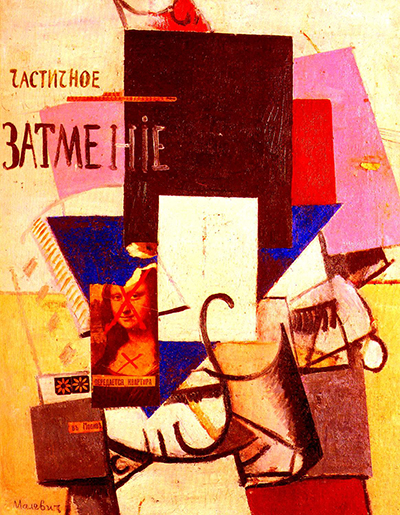Malevich created this piece at a time when he was moving away from objective art and embracing his newly invented Suprematism painting style. At the time, he condemned representational art citing it was theft from nature.
Kazimir said artists needed to construct on the basis of speed, weight and direction of movement, not objectivity. He managed to convey his beliefs by placing shapes against a plain background to eliminate spatial interpretations and infer relationships from the overlapping figures. In this composition, Malevich does not abandon representation entirely. He uses abstraction to dissect the picture plane and figure into different interlocking geometric shapes.
Mona Lisa's silhouette is still identifiable to illustrate Malevich had not abandoned representation completely. He includes a general palette of cool colours dominated by blues, greys, pink, white and black colours that add a visual dynamic to the composition. It shows Malevich’s intention to communicate.
Malevich created this piece at a time he had rejected reason. He wanted to be free from objective representations, which were primary to creating most paintings then. Kazimir adopted a fragmented style he called Alogical Federalism, which was best exhibited in this composition. This form of art was based on the Utopian ideals that were politically and artistically revolutionary. The piece also exhibits abstraction style through the use of a host of triangles, rectangles and vibrant colours. By confining himself to a small repertoire of colours, Malevich was able to achieve independence from objective art used by many Russian avant-garde painters at the time. The artist also showcases Mona Lisa's whole face; not in portions but surrounds the image with triangles and rectangles, so the Mona Lisa portrait does not become the subject matter of the painting.
Related Paintings: Black Square
This piece epitomised the theoretical principles of Suprematism. Though Kazimir had been influenced by the Cubism style, he believed this technique did not showcase the abstraction well enough. The 1915 Black Square painting displays this style perfectly in a single pictorial element. When creating this piece, Malevich believed that such forms should be free of reason and logic for the intended purpose to be fulfilled through feeling. The square symbolised feelings while the dark colour portrayed nothingness. The Black Square became the epitome of non-representational art. It explains why it was hung where other Orthodox paintings would traditionally be placed in the Russian exhibition.




